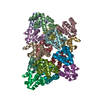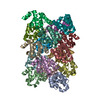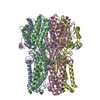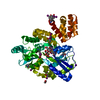+ Open data
Open data
- Basic information
Basic information
| Entry | Database: PDB / ID: 6xkj | ||||||
|---|---|---|---|---|---|---|---|
| Title | Cryo-EM structure of CARD8-CARD filament | ||||||
 Components Components | Caspase recruitment domain-containing protein 8 | ||||||
 Keywords Keywords |  IMMUNE SYSTEM / IMMUNE SYSTEM /  Filament / Filament /  inflammasome / inflammasome /  signaling / UPA / FIIND / CARD / signaling / UPA / FIIND / CARD /  NLRP1 NLRP1 | ||||||
| Function / homology |  Function and homology information Function and homology informationCARD8 inflammasome complex assembly /  NACHT domain binding / Formation of apoptosome / cysteine-type endopeptidase activator activity / inhibition of cysteine-type endopeptidase activity / negative regulation of NLRP3 inflammasome complex assembly / NACHT domain binding / Formation of apoptosome / cysteine-type endopeptidase activator activity / inhibition of cysteine-type endopeptidase activity / negative regulation of NLRP3 inflammasome complex assembly /  NLRP3 inflammasome complex / NLRP3 inflammasome complex /  CARD domain binding / negative regulation of lipopolysaccharide-mediated signaling pathway / self proteolysis ...CARD8 inflammasome complex assembly / CARD domain binding / negative regulation of lipopolysaccharide-mediated signaling pathway / self proteolysis ...CARD8 inflammasome complex assembly /  NACHT domain binding / Formation of apoptosome / cysteine-type endopeptidase activator activity / inhibition of cysteine-type endopeptidase activity / negative regulation of NLRP3 inflammasome complex assembly / NACHT domain binding / Formation of apoptosome / cysteine-type endopeptidase activator activity / inhibition of cysteine-type endopeptidase activity / negative regulation of NLRP3 inflammasome complex assembly /  NLRP3 inflammasome complex / NLRP3 inflammasome complex /  CARD domain binding / negative regulation of lipopolysaccharide-mediated signaling pathway / self proteolysis / Regulation of the apoptosome activity / CARD domain binding / negative regulation of lipopolysaccharide-mediated signaling pathway / self proteolysis / Regulation of the apoptosome activity /  Hydrolases; Acting on peptide bonds (peptidases) / regulation of canonical NF-kappaB signal transduction / Hydrolases; Acting on peptide bonds (peptidases) / regulation of canonical NF-kappaB signal transduction /  pattern recognition receptor activity / negative regulation of interleukin-1 beta production / negative regulation of NF-kappaB transcription factor activity / antiviral innate immune response / cysteine-type endopeptidase activator activity involved in apoptotic process / positive regulation of cysteine-type endopeptidase activity involved in apoptotic process / negative regulation of tumor necrosis factor-mediated signaling pathway / negative regulation of canonical NF-kappaB signal transduction / molecular condensate scaffold activity / positive regulation of interleukin-1 beta production / pattern recognition receptor activity / negative regulation of interleukin-1 beta production / negative regulation of NF-kappaB transcription factor activity / antiviral innate immune response / cysteine-type endopeptidase activator activity involved in apoptotic process / positive regulation of cysteine-type endopeptidase activity involved in apoptotic process / negative regulation of tumor necrosis factor-mediated signaling pathway / negative regulation of canonical NF-kappaB signal transduction / molecular condensate scaffold activity / positive regulation of interleukin-1 beta production /  peptidase activity / defense response to virus / regulation of apoptotic process / protein homodimerization activity / protein-containing complex / peptidase activity / defense response to virus / regulation of apoptotic process / protein homodimerization activity / protein-containing complex /  nucleoplasm / nucleoplasm /  nucleus / nucleus /  cytosol / cytosol /  cytoplasm cytoplasmSimilarity search - Function | ||||||
| Biological species |   Homo sapiens (human) Homo sapiens (human) | ||||||
| Method |  ELECTRON MICROSCOPY / helical reconstruction / ELECTRON MICROSCOPY / helical reconstruction /  cryo EM / Resolution: 3.54 Å cryo EM / Resolution: 3.54 Å | ||||||
 Authors Authors | Hollingsworth, L.R. / David, L. / Li, Y. / Sharif, H. / Fontana, P. / Fu, T. / Wu, H. | ||||||
| Funding support |  United States, 1items United States, 1items
| ||||||
 Citation Citation |  Journal: Nat Commun / Year: 2021 Journal: Nat Commun / Year: 2021Title: Mechanism of filament formation in UPA-promoted CARD8 and NLRP1 inflammasomes. Authors: L Robert Hollingsworth / Liron David / Yang Li / Andrew R Griswold / Jianbin Ruan / Humayun Sharif / Pietro Fontana / Elizabeth L Orth-He / Tian-Min Fu / Daniel A Bachovchin / Hao Wu /  Abstract: NLRP1 and CARD8 are related cytosolic sensors that upon activation form supramolecular signalling complexes known as canonical inflammasomes, resulting in caspase-1 activation, cytokine maturation ...NLRP1 and CARD8 are related cytosolic sensors that upon activation form supramolecular signalling complexes known as canonical inflammasomes, resulting in caspase-1 activation, cytokine maturation and/or pyroptotic cell death. NLRP1 and CARD8 use their C-terminal (CT) fragments containing a caspase recruitment domain (CARD) and the UPA (conserved in UNC5, PIDD, and ankyrins) subdomain for self-oligomerization, which in turn form the platform to recruit the inflammasome adaptor ASC (apoptosis-associated speck-like protein containing a CARD) or caspase-1, respectively. Here, we report cryo-EM structures of NLRP1-CT and CARD8-CT assemblies, in which the respective CARDs form central helical filaments that are promoted by oligomerized, but flexibly linked, UPAs surrounding the filaments. Through biochemical and cellular approaches, we demonstrate that the UPA itself reduces the threshold needed for NLRP1-CT and CARD8-CT filament formation and signalling. Structural analyses provide insights on the mode of ASC recruitment by NLRP1-CT and the contrasting direct recruitment of caspase-1 by CARD8-CT. We also discover that subunits in the central NLRP1 filament dimerize with additional exterior CARDs, which roughly doubles its thickness and is unique among all known CARD filaments. Finally, we engineer and determine the structure of an ASC-caspase-1 octamer, which suggests that ASC uses opposing surfaces for NLRP1, versus caspase-1, recruitment. Together these structures capture the architecture and specificity of the active NLRP1 and CARD8 inflammasomes in addition to key heteromeric CARD-CARD interactions governing inflammasome signalling. | ||||||
| History |
|
- Structure visualization
Structure visualization
| Movie |
 Movie viewer Movie viewer |
|---|---|
| Structure viewer | Molecule:  Molmil Molmil Jmol/JSmol Jmol/JSmol |
- Downloads & links
Downloads & links
- Download
Download
| PDBx/mmCIF format |  6xkj.cif.gz 6xkj.cif.gz | 236.4 KB | Display |  PDBx/mmCIF format PDBx/mmCIF format |
|---|---|---|---|---|
| PDB format |  pdb6xkj.ent.gz pdb6xkj.ent.gz | 196.6 KB | Display |  PDB format PDB format |
| PDBx/mmJSON format |  6xkj.json.gz 6xkj.json.gz | Tree view |  PDBx/mmJSON format PDBx/mmJSON format | |
| Others |  Other downloads Other downloads |
-Validation report
| Arichive directory |  https://data.pdbj.org/pub/pdb/validation_reports/xk/6xkj https://data.pdbj.org/pub/pdb/validation_reports/xk/6xkj ftp://data.pdbj.org/pub/pdb/validation_reports/xk/6xkj ftp://data.pdbj.org/pub/pdb/validation_reports/xk/6xkj | HTTPS FTP |
|---|
-Related structure data
| Related structure data |  22219MC  6xkkC  7keuC M: map data used to model this data C: citing same article ( |
|---|---|
| Similar structure data | |
| EM raw data |  EMPIAR-10567 (Title: CARD8-CT filament / Data size: 1.2 TB EMPIAR-10567 (Title: CARD8-CT filament / Data size: 1.2 TBData #1: Unaligned multi-frame micrographs for the CARD8 CT filament [micrographs - multiframe]) |
- Links
Links
- Assembly
Assembly
| Deposited unit | 
|
|---|---|
| 1 |
|
| Symmetry | Helical symmetry: (Circular symmetry: 1 / Dyad axis: no / N subunits divisor: 1 / Num. of operations: 16 / Rise per n subunits: 5.2 Å / Rotation per n subunits: -99.07 °) |
- Components
Components
| #1: Protein | Mass: 10103.373 Da / Num. of mol.: 16 / Fragment: CARD domain (UNP residues 451-537) Source method: isolated from a genetically manipulated source Source: (gene. exp.)   Homo sapiens (human) / Gene: CARD8, KIAA0955, NDPP1 / Production host: Homo sapiens (human) / Gene: CARD8, KIAA0955, NDPP1 / Production host:   Escherichia coli (E. coli) / References: UniProt: Q9Y2G2 Escherichia coli (E. coli) / References: UniProt: Q9Y2G2 |
|---|
-Experimental details
-Experiment
| Experiment | Method:  ELECTRON MICROSCOPY ELECTRON MICROSCOPY |
|---|---|
| EM experiment | Aggregation state: FILAMENT / 3D reconstruction method: helical reconstruction |
- Sample preparation
Sample preparation
| Component | Name: CARD8-CARD filament / Type: COMPLEX / Entity ID: all / Source: RECOMBINANT | ||||||||||||||||||||
|---|---|---|---|---|---|---|---|---|---|---|---|---|---|---|---|---|---|---|---|---|---|
| Molecular weight | Units: KILODALTONS/NANOMETER / Experimental value: NO | ||||||||||||||||||||
| Source (natural) | Organism:   Homo sapiens (human) Homo sapiens (human) | ||||||||||||||||||||
| Source (recombinant) | Organism:   Escherichia coli (E. coli) Escherichia coli (E. coli) | ||||||||||||||||||||
| Buffer solution | pH: 7.5 | ||||||||||||||||||||
| Buffer component |
| ||||||||||||||||||||
| Specimen | Conc.: 1 mg/ml / Embedding applied: NO / Shadowing applied: NO / Staining applied : NO / Vitrification applied : NO / Vitrification applied : YES : YES | ||||||||||||||||||||
| Specimen support | Grid material: COPPER / Grid mesh size: 400 divisions/in. / Grid type: Quantifoil R1.2/1.3 | ||||||||||||||||||||
Vitrification | Instrument: FEI VITROBOT MARK III / Cryogen name: ETHANE / Humidity: 100 % / Chamber temperature: 277.15 K |
- Electron microscopy imaging
Electron microscopy imaging
| Experimental equipment |  Model: Titan Krios / Image courtesy: FEI Company |
|---|---|
| Microscopy | Model: FEI TITAN KRIOS |
| Electron gun | Electron source : :  FIELD EMISSION GUN / Accelerating voltage: 300 kV / Illumination mode: FLOOD BEAM FIELD EMISSION GUN / Accelerating voltage: 300 kV / Illumination mode: FLOOD BEAM |
| Electron lens | Mode: BRIGHT FIELD Bright-field microscopy / Nominal magnification: 96000 X / Nominal defocus max: -2200 nm / Nominal defocus min: -800 nm / Cs Bright-field microscopy / Nominal magnification: 96000 X / Nominal defocus max: -2200 nm / Nominal defocus min: -800 nm / Cs : 2.7 mm : 2.7 mm |
| Specimen holder | Cryogen: NITROGEN / Specimen holder model: FEI TITAN KRIOS AUTOGRID HOLDER |
| Image recording | Average exposure time: 1.25 sec. / Electron dose: 40 e/Å2 / Detector mode: COUNTING / Film or detector model: FEI FALCON III (4k x 4k) / Num. of grids imaged: 1 / Num. of real images: 1208 |
- Processing
Processing
| Software | Name: PHENIX / Version: 1.18.2_3874: / Classification: refinement | ||||||||||||||||||||||||||||||||||||||||
|---|---|---|---|---|---|---|---|---|---|---|---|---|---|---|---|---|---|---|---|---|---|---|---|---|---|---|---|---|---|---|---|---|---|---|---|---|---|---|---|---|---|
| EM software |
| ||||||||||||||||||||||||||||||||||||||||
CTF correction | Type: PHASE FLIPPING AND AMPLITUDE CORRECTION | ||||||||||||||||||||||||||||||||||||||||
| Helical symmerty | Angular rotation/subunit: -99.07 ° / Axial rise/subunit: 5.2 Å / Axial symmetry: C1 | ||||||||||||||||||||||||||||||||||||||||
| Particle selection | Num. of particles selected: 287568 | ||||||||||||||||||||||||||||||||||||||||
3D reconstruction | Resolution: 3.54 Å / Resolution method: FSC 0.143 CUT-OFF / Num. of particles: 111333 / Symmetry type: HELICAL | ||||||||||||||||||||||||||||||||||||||||
| Atomic model building | Protocol: RIGID BODY FIT | ||||||||||||||||||||||||||||||||||||||||
| Atomic model building | PDB-ID: 4IKM Accession code: 4IKM / Source name: PDB / Type: experimental model | ||||||||||||||||||||||||||||||||||||||||
| Refine LS restraints |
|
 Movie
Movie Controller
Controller












 PDBj
PDBj





